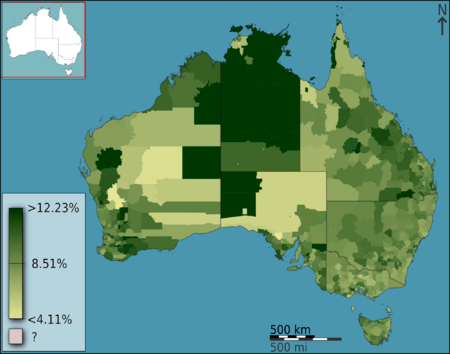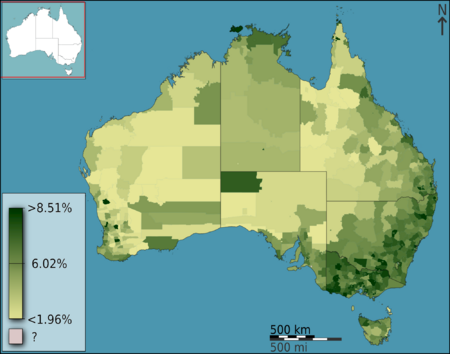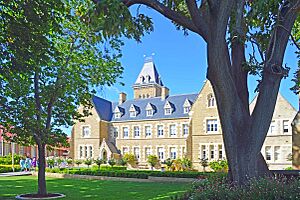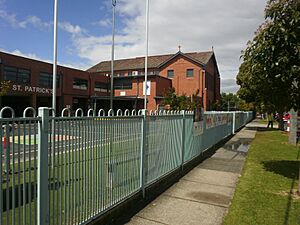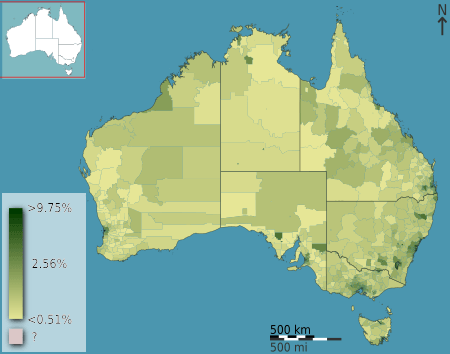Education in Australia facts for kids
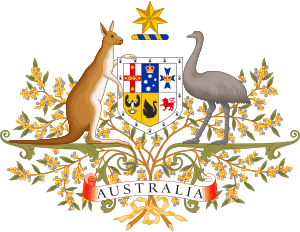 |
|
| Australian Government | |
|---|---|
| Minister for Education | Jason Clare |
| National education budget (2024–25) | |
| Budget | A$53 billion 7.2% of federal budget |
| General details | |
| Primary languages | English |
| System type | State |
| Established compulsory education | 1830s 1870s |
| Literacy (2003) | |
| Total | 99% |
| Male | 99% |
| Female | 99% |
| Enrollment (2021) | |
| Total | 20.4% of population |
| Primary | 2.0 million |
| Secondary | 1.6 million |
| Post secondary | 1.1 million |
| Attainment (2023) | |
| Secondary diploma | 79.1% |
Education in Australia helps young people learn and grow from early childhood all the way through university. It includes preschool, primary school, high school, and then higher education like universities or vocational training.
The different states and territories in Australia are mostly in charge of how education works and how it's paid for. However, the Australian Government also helps out with money.
In Australia, it's required by law for kids to go to school. This usually starts when they are five or six years old and continues until they are fifteen, sixteen, or seventeen. The exact ages depend on which state or territory they live in.
Most students, about 64%, go to government-run schools. The other 36% attend non-government schools, which include Catholic and independent schools. For university, most are public, and students can get a special loan called HECS to help pay for their studies. This loan is paid back once they earn a certain amount of money.
Australia has a national system for all qualifications, from school to university, called the Australian Qualifications Framework. Since 2010, a national Australian Curriculum has been used in primary and secondary schools.
In 2012, Australia was the third-biggest country for international students, after the United States and the United Kingdom. In 2018, a study called PISA showed Australian students ranked 16th in reading, 29th in maths, and 17th in science globally. However, the United Nations' Education Index in 2018 ranked Australia second-highest in the world for education quality.
Contents
- How Australian Education Works
- Primary and Secondary Schooling
- School Years in Australia
- Special School Types
- Mixed-Sex and Single-Sex Education
- Day and Boarding Schools
- Qualifications
- Basic Skills Tests (NAPLAN)
- International Students in Australian Schools
- Important Issues in Australian School Education
- Tertiary Education
- See also
How Australian Education Works
The states and territories are mainly responsible for education. This is because the Australian Government doesn't have a specific power in the Constitution to make laws about education. However, the federal government still helps by funding non-government schools and public universities. It also supports students with loans for higher education and oversees vocational training.
The school year in Australia usually starts in late January or early February. It finishes in early or mid-December for primary and secondary schools. Universities usually run from late February to mid-November. There are holidays and breaks throughout the year.
Early Learning and Preschool
Preschool is for children before they start primary school. It's not mandatory, but the government encourages families to enroll children aged around four. These programs help kids learn and get ready for school.
Many children first learn with others outside their family at daycare or playgroups. These are not usually considered formal schooling. Preschool is separate from primary school in most states. However, in Western Australia, preschool is part of the primary school system.
Most preschools are run by state or territory governments. In Victoria, South Australia, and New South Wales, local councils or private groups often run them. Preschool is for children aged three to five. About 85.7% of children attend preschool the year before they start formal school. Most government preschools offer 15 hours per week of learning for children in their final year before school.
Primary and Secondary Schooling
In 2023, over 4 million students were enrolled in nearly 10,000 schools across Australia. Government schools taught 64% of students. Catholic schools taught 19.7%, and independent schools taught 16.3%. There were over 311,000 full-time teachers in primary and secondary schools in 2023.
State and territory governments pay most of the costs for government schools. The Australian Government provides most of the public funding for non-government schools. This funding is often topped up by states and territories.
Non-government schools, whether religious or not, usually charge fees. Government schools are free, but many ask for "voluntary" fees to cover extra costs like stationery, textbooks, or school camps.
All schools, government or non-government, follow the same curriculum standards. The Australian Curriculum, Assessment and Reporting Authority manages this. Most schools also require students to wear school uniforms. The school year typically runs from January/February to December.
Required School Attendance
School is compulsory in Australia between certain ages. This depends on the state or territory and the child's birth date. Generally, it's from age five or six to age fifteen or seventeen.
In most states, children must attend school from age six. In Tasmania, it's from age five. However, most children start a preliminary year of formal schooling, often called kindergarten or prep, between four and a half and five and a half years old.
In 2024, about 79.9% of students stayed in school until Year 12. This shows how many students continue their education beyond the minimum leaving age.
The Australian Curriculum
The Australian Curriculum sets out what all young Australians should learn. This ensures that students get a similar education no matter where they live. It aims to improve the quality and fairness of education.
For pre-Year 1 to Year 9, the curriculum covers eight main learning areas. These include English, Mathematics, Science, Humanities and Social Sciences, The Arts, Technologies, Health and Physical Education, and Languages. For Years 10, 11, and 12, there are specific subjects in English, Maths, Science, History, and Geography. The curriculum also sets standards for what students should know and be able to do in each subject.
Types of Schools
Schools in Australia are mainly divided into two types: government schools and non-government schools. Non-government schools include Catholic schools and other private schools. In 2019, about two-thirds of students attended government schools, and one-third attended non-government schools.
Government schools are run by the state or territory government. They are free to attend. Students usually go to a school in their local area. However, sometimes they can get permission to attend another school, for example, if they have special academic talents or a disability.
Non-government schools receive funding from the Australian Government and state/territory governments. Parents usually pay fees for their child's education at these schools.
A small number of students are home-schooled, especially in rural areas. Some of these students use the School of the Air. This program helps children in remote areas get primary and secondary education. It started with radio broadcasts and now uses online classes.
Government Schools
Government schools are also known as state schools or public schools. They educate about two-thirds of all students in Australia. While they offer free education, many ask parents for a contribution fee. This helps cover costs for things like stationery, uniforms, and school camps.
Government schools can be:
- Open or comprehensive schools: These accept all students from their local area.
- Selective schools: These choose students based on academic ability.
- Special schools: These are for students with specific learning needs or disabilities.
- Specialist schools: These focus on particular areas like arts or sports.
Some government schools are called "Independent Public Schools." They are still part of the state system but have more freedom in their decisions.
Government hospital schools are found in some major hospitals. They provide education for students who need to stay in hospital for a long time.
Non-Government Schools
Non-government schools operate under state or territory rules but are not run by government departments. They can be individual schools, small groups, or large systems like Catholic schools. All non-government schools get funding from the Australian Government.
Catholic Schools
The Catholic education system in Australia started in 1820. It is now the second-largest provider of school education. In 2018, one in five Australian students attended Catholic schools. There are over 1,700 Catholic schools with more than 750,000 students and almost 60,000 teachers.
Most Catholic schools are "systemic," meaning their funding goes to a central Catholic Education Commission. This commission then distributes the money based on the schools' needs. Some Catholic schools are "independent" and receive government grants directly.
Private Schools
Private schools are non-government schools that operate independently. They are usually run by a school council or board. These schools vary greatly in what they offer and the types of families they serve. Some are run by religious groups, while others have no religious ties. Some focus on specific teaching methods, like Waldorf-Steiner schools.
In 2018, there were 1,140 private schools in Australia, making up 12% of all schools. They enrolled over 617,000 students, which is 16% of the student population.
Private school fees can vary a lot, from under $100 per month to thousands of dollars. The most expensive private schools can charge very high fees for a full 13 years of education.
Private schools in Australia include:
- Schools linked to Christian groups (like Anglican, Catholic, Lutheran, Uniting Church, Presbyterian, Baptist).
- Non-denominational Christian schools.
- Islamic schools.
- Jewish schools.
- Montessori schools.
- Steiner schools.
- Schools created by special laws (like some grammar schools).
- Indigenous community schools.
- Schools for students with disabilities.
- Schools for students facing social or emotional challenges.
School Years in Australia
Primary Schools
Primary schools generally cover a child's education from pre-Year 1 to Year 6. In South Australia, until 2022, primary school went up to Year 7. Primary schools focus on teaching essential reading, writing, and maths skills. They also give children basic knowledge about the world.
Secondary Schools
Secondary schools are also called high schools or colleges. They usually cover Year 7 to Year 9 (the compulsory period) and continue to Year 12. As students move into secondary school, subjects become more specialized. This allows students to focus on areas like science, technology, engineering, and maths (STEM), or humanities and social sciences.
Middle Schools
Middle schools are not very common in most Australian states. Students usually go straight from primary to secondary school. Some secondary schools divide their grades into "junior high school" (Years 7-9) and "senior high school" (Years 10-12).
The Northern Territory introduced a three-tier system in 2006. This system includes middle schools for Years 7 to 9 (ages 12-15) and high schools for Years 10 to 12 (ages 15-18).
Combined and Central Schools
Combined schools, also known as K-12 schools, have both primary and secondary year levels. These schools can be in cities, regional areas, or rural areas. In 2019, there were about 500 combined government schools and 850 combined non-government schools.
In Western Australia, these are called district high schools and teach students from pre-prep to Year 10. In New South Wales, Central schools are mostly government schools in rural areas. They provide primary and lower secondary education, usually up to Year 10.
Special School Types
Special Schools
A special school is for students who have special educational needs. This could be due to learning difficulties, physical disabilities, or other challenges. These schools are designed with special staff and resources to help these students. Class sizes are smaller, and there are more teachers and support staff per student. Some special schools also have therapists.
Selective Schools
A selective school is a government school that chooses students based on certain criteria, usually academic ability. This is different from a comprehensive school, which accepts all students.
In New South Wales, getting into selective high schools is very competitive. About 3,600 places are offered to 15,000 students who take the Selective High School Test. In 2019, there were 47 fully or partly selective government high schools.
In Victoria, four selective government high schools choose students based on an entrance exam. There are also three special schools focused on arts and science. Queensland has four selective entry high schools, including the Queensland Academies. Western Australia has a Gifted and Talented Education (GATE) program. Students take an entrance test and may have interviews or auditions.
Specialist Schools
Specialist schools offer programs focused on specific areas like arts or elite sports. In South Australia, specialist schools cover arts, gifted programs, languages, agriculture, STEM, and sports. In Victoria, examples include schools for science and maths, performing arts, and sports.
International Schools
International schools in Australia promote global education. They might be run by another country's government, the local state government, or as private schools. Many offer programs like the International Baccalaureate. Some are linked to specific cultures or languages, such as French, German, or Japanese schools.
Mixed-Sex and Single-Sex Education
In Australia, schools can be either co-educational (boys and girls learn together) or single-sex (boys and girls learn separately). Most schools are co-educational. A small number of government schools are single-sex, usually secondary schools. For example, some suburbs have separate boys' and girls' high schools.
Most single-sex schools in Australia are non-government, especially private schools. Some Catholic schools are also single-sex, but most Catholic schools are co-educational.
Day and Boarding Schools
Schools in Australia can be day schools (students go home each day) or boarding schools (students live at the school). In 2019, about 250 schools (less than 2.5%) were boarding schools. Some boarding schools are for boys only, some for girls only, and some are co-educational. Some offer flexible options, like full-time boarding or going home on weekends.
Qualifications
Each state and territory gives out certificates to secondary students when they finish school. This is called the Senior Secondary Certificate of Education. Here are some examples:
- ACT: ACT Senior Secondary Certificate
- NSW: NSW Higher School Certificate (HSC)
- Northern Territory: NT Certificate of Education and Training (NTCET)
- Queensland: Queensland Certificate of Education (QCE)
- South Australia: South Australian Certificate of Education (SACE)
- Tasmania: Tasmanian Certificate of Education (TCE)
- Victoria: Victorian Certificate of Education (VCE)
- Western Australia: Western Australian Certificate of Education (WACE)
Students can also choose to get an International Baccalaureate Diploma Programme certificate.
Basic Skills Tests (NAPLAN)
Australia has national tests to check students' basic skills. The main one is the National Assessment Program – Literacy and Numeracy (NAPLAN). These tests check students' reading, writing, spelling, grammar, punctuation, and maths.
NAPLAN started in 2008. It's given to students in Years 3, 5, 7, and 9 across Australia. The tests help see if students are meeting learning goals. Parents can decide if their children take the test. Most students participate.
Other international tests like PISA, TIMSS, and PIRLS compare Australian students' results with students worldwide.
International Students in Australian Schools
An "international student" is someone who studies in Australia but is not an Australian citizen, permanent resident, or New Zealand citizen. The Australian Government has rules for international students who come to study.
In 2019, about 812,000 international students were enrolled in Australian universities and vocational schools. International education is a big export for Australia. Many international students stay in Australia after they graduate.
Important Issues in Australian School Education
School Funding
In 2010, a report called the "Gonski Report" looked at how Australian schools are funded. It suggested a plan to provide more money for schools. After some changes, new funding agreements between the Australian Government and each state and territory started in 2019.
These agreements provide funding for government schools (20%) and non-government schools (80%). The funding considers how many students are enrolled and their specific needs.
In 2024–25, the Australian Government invested A$53 billion in education. In early 2025, South Australia, Victoria, New South Wales, and Queensland signed new funding agreements. These agreements will increase federal funding for public schools to 25% of the recommended amount.
Indigenous Education
Aboriginal and Torres Strait Islander children often face challenges in school compared to other Australian students. In 2008, the government set "closing the gap" targets. Four of these targets were about education:
- More Indigenous four-year-olds in early childhood education by 2025.
- Halving the gap in reading, writing, and maths for Indigenous students by 2018.
- Halving the gap in Year 12 completion rates for Indigenous 20-24 year olds by 2020.
- Closing the gap in school attendance rates by 2018.
By 2018, 95% of Indigenous children were enrolled in preschool, which was above the target. However, data for reading, writing, and maths was not available. Year 12 attainment rates for Indigenous students were lower than non-Indigenous students, especially in remote areas. Attendance rates were also lower for Indigenous students.
Bilingual Education
Bilingual education means teaching in two languages. In Australia, this can be for Indigenous students, students from diverse language backgrounds, or English speakers learning another language. It helps keep languages alive.
In the Northern Territory, bilingual programs for Indigenous students started in the 1970s. Schools like Yirrkala Community School have successfully taught in both Indigenous languages (like Yolngu Matha) and English. This "both-ways" learning has helped students stay in school and achieve good results. In March 2025, Yuendemu School celebrated 50 years of teaching in Warlpiri alongside English.
Currently, funding for bilingual education in the Northern Territory is part of general school budgets. This means each school decides how to fund these programs.
Religious Education in Government Schools
Australia is a secular country, meaning it doesn't have an official religion. However, religious education is offered in government schools. The rules for this vary by state.
In New South Wales, students can attend "Special Religious Education" classes to learn about a chosen religion. In Queensland, religious groups can offer approved programs if the school principal agrees. In Victoria, schools cannot promote one religion, but principals can allow short "special religious instruction" classes. In Western Australia, both special religious education and general religious education are offered.
School Violence
School violence is a concern in Australia. In 2009, the Queensland Minister for Education said that rising violence in schools was "totally unacceptable." In 2008, 55,000 students in Queensland were suspended, with nearly a third for physical misconduct.
In South Australia, 175 violent attacks against students or staff were recorded in 2008. Students caused 3,000 injuries reported by teachers over two years (2008-2009).
As of 2024, school violence is still an issue. A survey found that 48% of school principals had seen or experienced physical violence.
Tertiary Education
Tertiary education, or higher education, is what you do after high school. It usually means studying at a university or a vocational training provider (like TAFE). This leads to a degree, diploma, or certificate.
In 2021, over 1.1 million students were attending university or other higher education. Australia has 42 universities: 37 public and 5 private. Monash University in Melbourne is the largest, with 75,000 students. The Group of Eight is a group of eight top Australian universities known for their research.
All students doing nationally recognized training need a Unique Student Identifier (USI).
International Tertiary Students
Australia has a very high number of international students compared to its population. In 2019, 812,000 international students were enrolled in universities and vocational schools. International education is one of Australia's biggest exports. Many international students stay in Australia after they graduate.
The biggest groups of international students in 2025 were expected to come from China, India, Vietnam, Thailand, Nepal, Malaysia, Brazil, and South Korea.
Rankings
In 2018, the United Nations' Education Index ranked Australia second-highest in the world for education quality. In the 2018 PISA study, Australian school students ranked 16th in reading, 29th in maths, and 17th in science globally. The Australian Education Union believes that cuts in government funding have led to these declining student outcomes.
Many Australian universities are highly ranked globally. In 2021, 36 Australian universities were listed in the QS World University Rankings. In 2020, The University of Melbourne was ranked 35th globally in the Academic Ranking of World Universities.
See also
- Education in the Australian Capital Territory
- New South Wales § Education
- Education in South Australia
- Education in Tasmania
- Education in Victoria
- Education in Western Australia
- Homeschooling and distance education in Australia
- Lists of schools in Australia
- Music education in Australia
- Tertiary education in Australia
- Tertiary education fees in Australia


